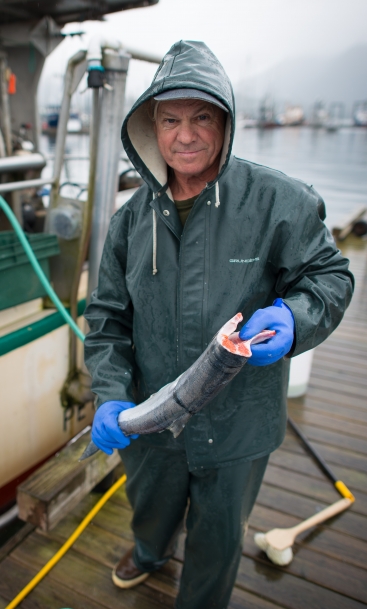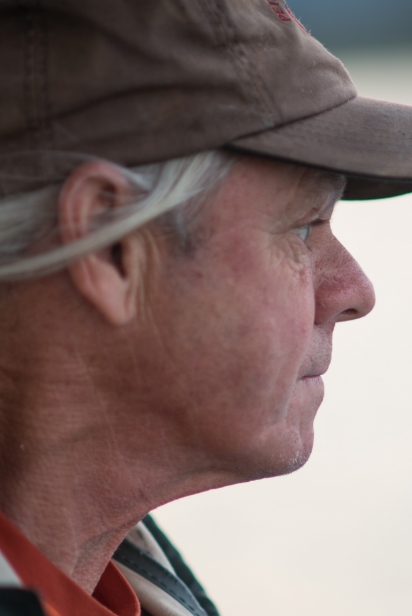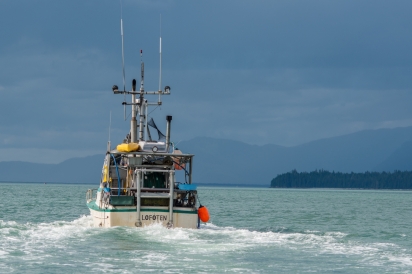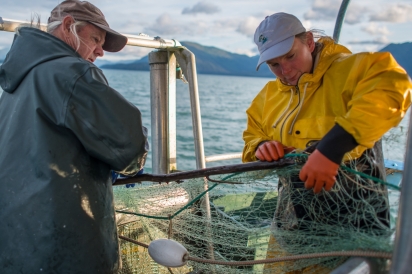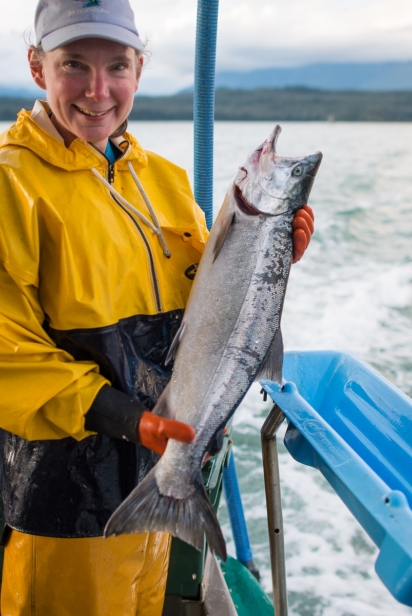FISHING FOR SUSTAINABILITY: An Alaskan couple brings artisanal salmon to Idaho
After pouring his first cup of coffee, George Meintel climbs out of his fishing boat’s cabin and into the quiet, pre-dawn blue of a southeast Alaskan morning. The air smells of sitka spruce and saltwater. Chop slaps against the hull. A loon calls.
To the east, the glaciated Coast Range of Canada towers like a jagged white wall of ice; to the west, the heavily forested Kupreanof Island stands dark and green. It has to be one of the world’s most stunning spots, but Meintel has other things on his mind.
He watches the tide push the current through Frederick Sound as he takes a slow sip from his cup, imagining the unseen river of salmon migrating just below the surface from the Gulf of Alaska west to spawning grounds in the nearby Stikine River. His job is to put his 36-foot boat, the Lofoten, and its 1,800-foot length of gillnet between those fish and their destination. That’s what Alaskan salmon fishermen do and Meintel, who now lives the off-season in idaho, has been doing that for a quarter century.
Once he’s decided where the fish should be, Meintel shatters the dawn quiet by firing up his diesel engine, pulling anchor and motoring on a path perpendicular to those imagined salmon. Once in position, he throws a buoy attached to his gillnet over the stern and starts heading across the flow of water, reeling out netting off a motorized drum.
“A gillnet,” Meintel says, “has a weighted line on the bottom and a floating line on the top and it hangs kind of straight up and down like a tennis net.” He continually looks over his shoulder to make sure the net is reeling out smoothly. About then, Cynthia Wallesz, Meintel’s wife and fishing partner for over 20 years, climbs out of the cabin and begins preparing for the first catch of the day. “It’s such a good place to fish,” she says as she slips on rain gear and gloves. “The waters are so pristine and the habitat is so pure.”
The Monterey Bay Aquarium’s Seafood Watch program, which rates the sustainability of commercial fishing, would back Wallesz up. The aquarium gives Alaskan salmon its “Best Choice” or highest rating, saying that “in Alaska, management of salmon fisheries is highly effective” and there is little to no by-catch of other species in the alaskan salmon fishery.
Still, that pristine, pure vision fades a little once the couple motors back to Petersburg. One of alaska’s most active fishing villages and Wallesz’s and Meintel’s summer home, Petersburg is picturesque, but three large canneries specializing in high-volume industrial processing and global distribution loom over the docks. Chimneys belch steam, winches whine and seasonal cannery workers from as far away as Latin America and Eastern Europe march into the plants with every shift change. from June through august, Petersburg has the frenetic feel of a gold rush town—but the fishermen’s traditional part in that frenzy ends as soon as their catch hits one of those canneries.
That’s why Wallesz and Meintel decided to take a different path several years ago. They’d grown tired of merely being the first link in what was often a very long, impersonal food chain. Like cattlemen who tire of shipping their herds to distant feedlots or wheat growers who sell their crops on the commodity market, Wallesz and Meintel yearned to take control of their catch: They wanted to process, package and direct- market a portion of their salmon themselves, focusing on quality over quantity. but unlike farmers and ranchers who can turn to local markets as an alternative to industrial agriculture, an alaskan fisherman living in a town awash with fish and other fishermen has to look farther afield for customers—and that’s where idaho comes in.
Wallesz and Meintel began shipping small quantities of fish around the country in 1999, but decided to make a more personal commitment to boise when it became one of their more receptive markets. In 2004, they began selling salmon through a vendor at the Capitol City Public Market, then moved to the Boise Farmers Market when it opened in 2013. Still, it took the couple a while to convince Idaho customers that buying fish from Alaska somehow fit the philosophy of the local food movement. Yet, when they found the time to come to Boise and explain face-to-face how hands-on, small-scale and qualityoriented their style of fishing had become—in other words how truly artisanal—people got it.
It’s obvious when you’re on the Lofoten that the word artisanal isn’t merely a marketing ploy. instead of simply tossing each fish into a hold for the canneries to deal with, Wallesz and Meintel pluck the best looking sockeye, coho and chum from their net as they reel them in, immediately bleed, gut and then pressure bleed each one with a pressurized rubber hose. They then place those fish in slush ice that chills
them quickly to 33°f. That immediate care goes a long way in preserving the flavor and quality of fish that might otherwise sit for hours, even days, in a hold before cleaning. once the couple gets back to Petersburg, Cynthia boxes up the fresh fish, drives it to the local airport in their rattling ’93 Nissan pickup and immediately ships it to boise and a few other destinations. They take fish that’s destined to be filleted and frozen to one of Petersburg’s custom processors that have popped up as small-scale alternatives to the mega-canneries (a small but growing percentage of alaskan fishermen are trying the direct marketing approach, some of them also selling fish in idaho).
“It’s a whole lot of work,” Meintel says of this artisanal approach to salmon fishing. “it’s way more work than taking your fish and giving it to a [big] processor, but it’s been infinitely rewarding.”
The couple began spending as much time as they could in Boise (Wallesz often flying to town while Meintel fished with an assistant), running their booth at the boise farmers Market, servicing local clients like the Boise Co-op, Reel Foods Fish Market and Smoky Davis, and
generally spreading the gospel of artisanal salmon around the Treasure Valley. Wallesz even started a consulting business to help teach other
commercial fishermen how to sell their catch directly.
That connection to Idaho grew strong enough that four years ago, Wallesz and Meintel bought a house in Boise. They did it in part to market their fish more efficiently, but also to have a scenic, outdoorsy second home to live in during Alaska’s fishing off-season. During that time, you can find the two hiking the Boise foothills, camping in the Sawtooths or prowling downtown streets on First Thursday. They’re even considering retiring to boise in some unspecified future.
Yet, when you see Meintel dropping anchor in the lee of a spruce covered island after a long day of fishing, you wonder if this 63-yearold will ever retire. Once he cuts that engine and the alaskan quiet comes rushing back in, he takes a deep breath. He changes his shoes and wet clothes, pops open a beer, starts a one-pot meal and just sits down and takes it all in.
“There’s nothing more fun than catching fish,” he says as the summer sun stubbornly lingers on the horizon. “And when you turn that diesel engine off after listening to it for 15, 16 hours a day, it’s the sweetest sound you’ll ever hear. And you look around and see what’s all around you and feel like you’re a pretty lucky person.”
He takes a slow sip of beer and smiles. “There’s just something about wild salmon that makes life fun.”


